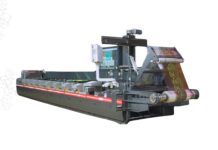Asepto is a complete liquid packaging solution from the global UFlex group comprising the liquid packaging laminate plant in Sanand in Gujarat and liquid packaging filling and sealing machines manufactured at the UFlex engineering division in Noida. We have written comprehensively about the Sanand plant based on our visit there and we carry this interview with Asepto president and CEO Ashwani Kumar Sharma as the capacity in Sanand is imminently being doubled with the investment in a second and soon to commissioned Gallus press. – Editor
Packaging South Asia – Your comments on the increasing competition in the liquid packaging market in India and the overall outlook for growth in the market.
Ashwani Sharma – India offers great potential for the aseptic liquid packaging. The current market is poised at about 12-13 billion packs annually, and it is increasing at a CAGR of 12-15% annually. This offers the sector the opportunity to grow on the backdrop of emerging products that require aseptic packaging. It also shows that there is a large playing field available to seize the latent opportunities in aseptic packaging. In my opinion, the consumption for liquid products will only rise in the future, which will also increase the demand for products to offer longer shelf life, without preservatives, and to be packed safely and hygienically. Therefore, the scope of aseptic packaging will rise significantly, and only innovation and creation of newer product categories leveraging the aseptic packaging opportunities will be able to command a strong market position.
Since Asepto’s inception, we have seen significant growth with several new categories emerging such as energy drinks, ready-to-drink ORS, and plant-based drinks to mention a few. They’ve carved out a place for themselves across the country and are contributing significantly to the growth of the aseptic liquid packaging market. Another prospective category to watch out for is aseptically processed and packaged mineral water. This category is presently being reviewed by the relevant regulatory organizations. The leading mineral water firms in India are concentrating on increasing their market share through efficient marketing methods and appealing packaging.

In addition, India is the world’s largest milk producer, yet this doesn’t translate into adding to the share of its aseptic packaging, which remains dismally low. Aseptic processing (UHT) and packaging for white milk and milk products such as ghee, buttermilk, lassi, drinking yoghurt, milk shakes, and flavored milk among others, have huge potential in India.
Milk and milk products, being highly perishable, remain fresh and free from contamination for 6 to 9 months in aseptic packs depending on the product filled inside. The significant benefit of aseptic liquid packaging is that milk, a staple meal in India, can be readily made available in even the remotest corners of the nation without refrigeration or use of preservatives. Therefore, we anticipate great scope here as well for aseptic packaging.
Another aseptic packaging segment which will grow in future is the alcoholic beverages. It has a significant potential considering the fact that aseptic packs are anti-counterfeit and tamper-proof. End consumers are also becoming more aware of the benefits of aseptic packs versus glass or PET bottles, which will surely spill over to other product segments.
PSA – When will the doubling of capacity at Asepto Sanand be implemented and what is the outlook for utilization?
Ashwani Sharma – Driven by a robust order book and consistent market growth, we are doubling the manufacturing capacity of our aseptic liquid packaging plant in Sanand. As a result, we want to drive expansion at a rapid pace. Our production capabilities will now be stronger than ever in order to fulfil the global demands.
We have already captured around 20% of the domestic market share in less than four years, which has resulted in our existing full capacity utilization. The doubling of our Sanand plant’s production capacity is lined up next and should be rolled out soon. This step will be a great achievement considering we have almost set up the line when the global economy has not yet recovered completely from the unprecedented stress caused by the Covid-19 crisis and has been cautious about expansions.
PSA – Is Asepto doing any R&D on the recyclability of the laminate it makes since we are getting reports from other companies of liquid packaging laminates without aluminium and we expect more developments from others in the field as well.
Ashwani Sharma – Yes, we are aggressively working on our R&D to make our products even more sustainable. In fact, you will be happy to know that UFlex is also working on a technology of upcycling the paper board component of the post-consumer Aseptic waste. The process employs an enzymatic de-lam technology to separate the paper portion and convert it into paper-pulp. This upcycling technology is not only unique but an example of sustainability in the real sense.
In the current composition of our 6-layer aseptic packaging, a very thin coating of aluminium is used that acts as a strong light and oxygen barrier, eliminating the need for refrigeration and preventing spoilage of the product without the need of preservatives. The metal (aluminum) is just used as an induction sealing agent in aseptic filling machines. To completely eliminate aluminium from the system, we will need to do a technological overhaul that will involve the paperboard supplier and the present filling technology of the production process, which may be accomplished in due course.
PSA – What is the progress of the Asepto liquid packaging filling and sealing machines in the market?
Ashwani Sharma – As a total system supplier, UFlex Asepto aims to provide the best filling speed, accuracy, and flexibility while ensuring product and packaging sterility throughout the process. So far, we’ve sold 17 machines, with 13 already installed and operational at our customers’ manufacturing facilities.












